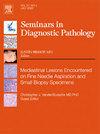一种适应和改进的数字病理学实施验证协议
IF 3.5
3区 医学
Q2 MEDICAL LABORATORY TECHNOLOGY
引用次数: 0
摘要
数字病理学(Digital Pathology,DP)通过对组织样本进行快速高效的分析,正在改变疾病诊断的方式。然而,确保诊断的准确性和可靠性至关重要。本手稿概述了大学健康网络(UHN)为实施初级临床评估的数字化工作流程而开发定制验证协议的历程。借鉴英国皇家病理学家学会 (RCPath) 和美国病理学家学会 (CAP) 的指导方针,UHN 对其方法进行了调整,以适应其 14 个亚专科小组的独特需求。我们的方案强调病理学家主导的自我验证、整合不同的亚专科病例以及分阶段推出并持续监控。此外,受利兹大学(CCP)启发而采用的变革管理原则在指导流程、确保病理学家适应数字化工作流程以及应对亚专科特定挑战方面发挥了至关重要的作用。这一全面的验证协议支持了 UHN 更广泛的目标,即在确保患者安全和数据完整性的同时,将 DP 用于临床实践。本文章由计算机程序翻译,如有差异,请以英文原文为准。
An adapted & improved validation protocol for digital pathology implementation
Digital Pathology (DP) is transforming disease diagnosis by providing rapid and efficient analysis of tissue samples. However, ensuring the accuracy and reliability of diagnoses is crucial. This manuscript outlines University Health Network (UHN)'s journey towards the development of a customized validation protocol for implementing a digital workflow for primary clinical assessment. Drawing on guidelines from the Royal College of Pathologists (RCPath) UK and the College of American Pathologists (CAP), UHN has tailored its approach to accommodate the unique needs of its 14 subspecialty groups. Our protocol emphasizes pathologist-led self-validation, integration of diverse subspecialty cases, and a phased rollout with continuous monitoring. Additionally, the use of change management principles inspired by Leeds University (CCP) played a critical role in guiding the process, ensuring pathologists’ comfort with digital workflows, and addressing subspecialty-specific challenges. This comprehensive validation protocol supports UHN’s broader goals of leveraging DP for clinical practice while ensuring patient safety and data integrity.
求助全文
通过发布文献求助,成功后即可免费获取论文全文。
去求助
来源期刊
CiteScore
4.80
自引率
0.00%
发文量
69
审稿时长
71 days
期刊介绍:
Each issue of Seminars in Diagnostic Pathology offers current, authoritative reviews of topics in diagnostic anatomic pathology. The Seminars is of interest to pathologists, clinical investigators and physicians in practice.

 求助内容:
求助内容: 应助结果提醒方式:
应助结果提醒方式:


